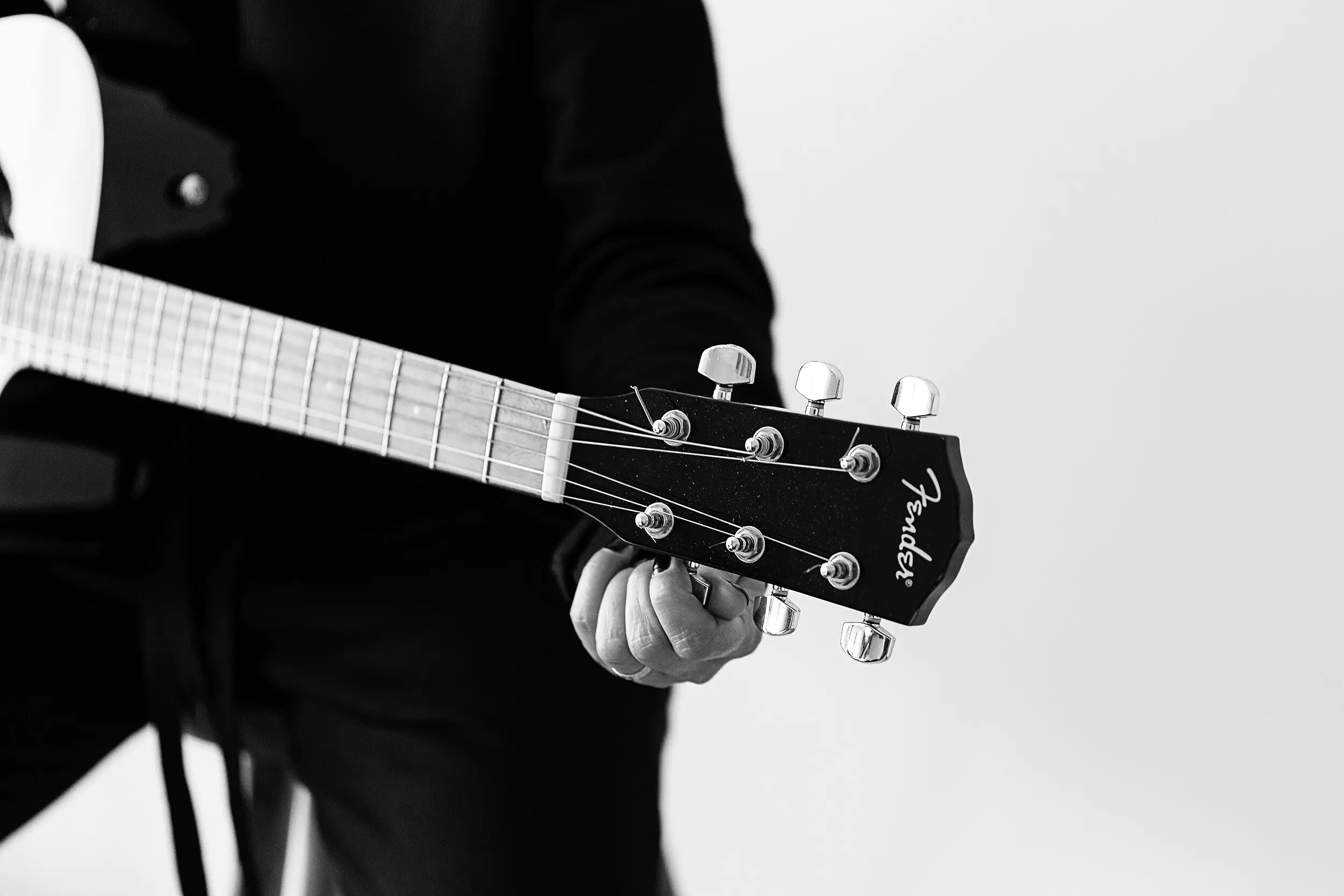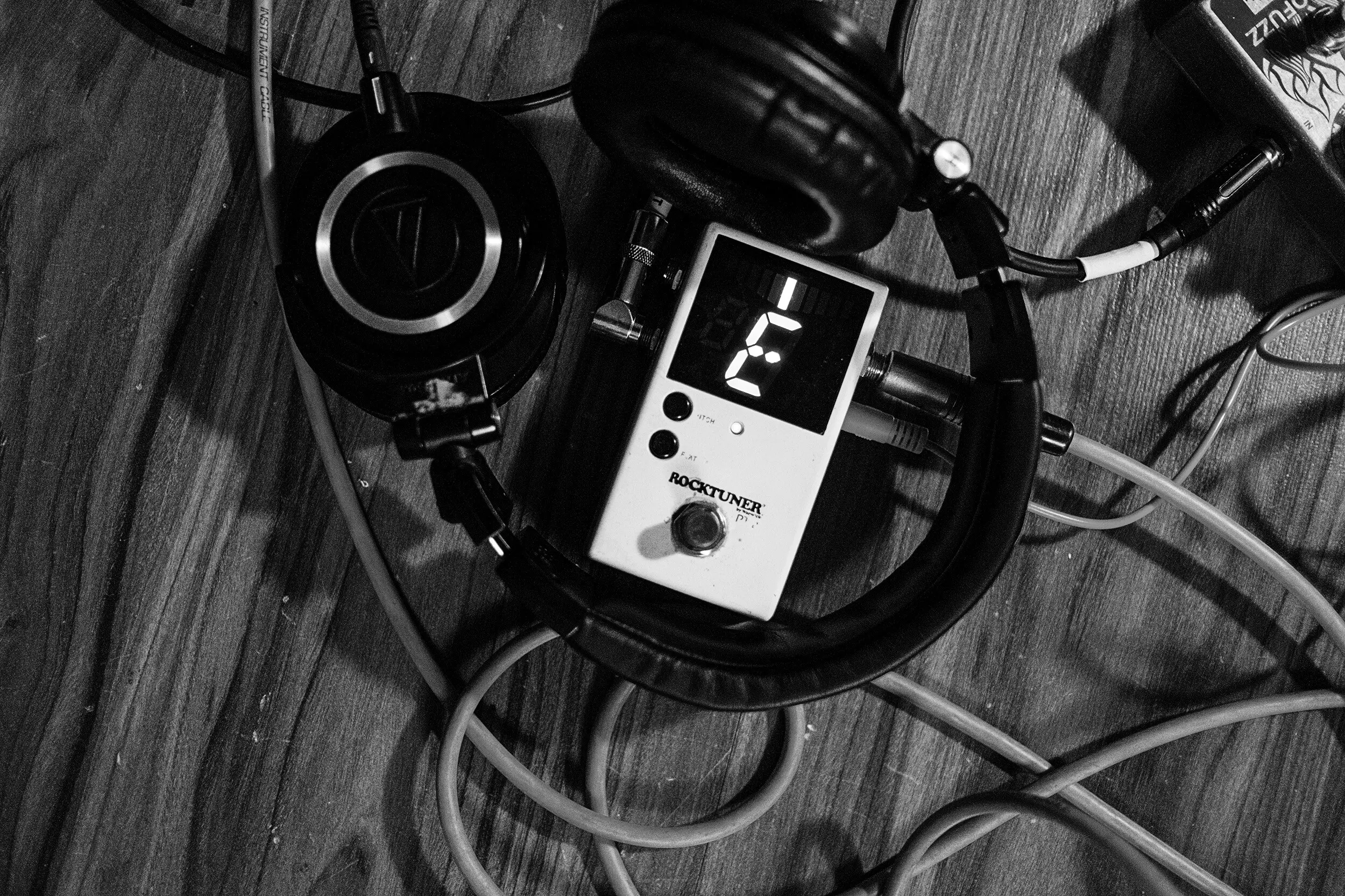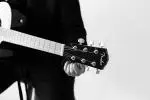Tuning is the process of altering the pitch of musical instruments to meet an accepted standard. The process is key to producing harmonious melodies and chords.

What is Tuning: Table of Contents
In the world of music, ‘tuning’ is a crucial term that goes beyond mere dictionary definitions. When we talk about tuning, we refer to the precise adjustment of the pitch of the notes produced by an instrument. This involves getting an instrument in harmony with itself, ensuring that when you strum a string, blow a horn, or hit a drum, the sound produced matches the expected note.
But tuning goes further than just aligning to the standard pitch of A440 Hz, used as the concert pitch in many parts of the world. It also encompasses adjusting the pitches to different tuning systems or scales, ensuring coherence in the notes produced and harmonious interactions between them. In essence, tuning is the bridge between an instrument’s physical structure and the intangible world of music it creates, allowing musicians to express themselves and communicate their emotions accurately.
The Science of Tuning
Diving deeper into tuning requires a basic understanding of sound physics. Sound is, essentially, a type of energy made by vibrations. When an instrument creates sound, it’s sending waves through the air, which our ears catch and our brains interpret. The characteristics of these waves, including their frequency, impact the notes we hear.
Read More: What is Frequency Range?
How does Sound Physics Relate to Tuning?
The frequency of a sound wave is counted in cycles per second or Hertz (Hz), and it determines the pitch of the note. Higher frequency means a higher pitch and vice versa. When a musician is tuning an instrument, they are adjusting the frequency at which the instrument vibrates, altering the pitch of the sound it produces.
What is the Role of Frequency and Pitch in Tuning?
In the context of stringed instruments, such as a guitar or violin, adjusting the tension in the strings changes their frequency. Tightening a string increases its frequency, thus raising the pitch, while loosening it decreases the frequency, lowering the pitch. For wind instruments, the length of the air column that vibrates can be modified to achieve different pitches.
The Art of Tuning: Different Types and Techniques

What is Standard Tuning?
Standard tuning is the prevalent system embraced by musicians for stringed instruments, be it a guitar, violin, or viola. Let’s take a six-string guitar as an example: the lowest string, also known as the sixth string, is the thickest and tuned to E. Progressively, we tune the rest of the strings as A, D, G, B, and finally, the thinnest, the first string, tuned to E. Standard tuning holds an immense advantage, simplifying the playing of chords and scales, thereby making it a musician’s first choice.
What are Alternate Tunings?
Music is an art form that thrives on exploration and diversity. While standard tuning provides a solid foundation, it’s not the be-all-end-all of tuning. Alternate tunings come into play here, offering a different tonal landscape for musicians to explore. These range from open tunings, dropped tunings, to a host of others that push the boundaries of sound. In open tuning, the strings correspond to a specific chord when played without any frets being held down, allowing for a distinct musical color. Take for instance, the songs “Romeo and Juliet” by Dire Straits and “Fearless” by Pink Floyd; they’ve utilized alternate tunings to their advantage, thereby enriching their songs with unique tonal qualities.
What Techniques are used in Tuning Stringed Instruments?
Tuning a stringed instrument is not simply a matter of adjusting the strings but a technique that varies based on preference, circumstance, and the instrument itself. The most time-honored method is tuning by ear, employing a reference pitch. This could be a tuning fork, a pitch pipe, or another instrument that’s already in tune. Musicians keenly listen to this reference and then adjust the tension of their own instrument’s strings until the two pitches are harmonious.
However, in the modern age, electronic tuners have gained popularity due to their precision and ease of use. These devices can detect the pitch of the played string and visually indicate whether it’s in tune, flat (too low), or sharp (too high). They are particularly beneficial for beginners or in noisy environments where discerning subtle pitch differences can be challenging.
Finally, in this digital era, we can’t overlook the rise of tuning apps and online tools. They offer an easily accessible, user-friendly, and remarkably accurate way of tuning your instrument. Regardless of whether you’re a novice or a seasoned musician, tuning is no longer a daunting task but an essential part of the music-making process that can be achieved with the right tools and techniques.
Fine-Tuning Creation and Performance: The Role of Tuning
The process of tuning is more than just a preparatory step; it is a defining factor in the creation and performance of music. When a piece of music is perfectly in tune, it means that the instruments are harmonizing, creating a balanced sound that is pleasing to the ear. It’s the backbone that supports the melody, rhythm, and harmony of a piece, allowing for a seamless blend of musical elements.
Conversely, an out-of-tune performance can detract from the beauty of the music, leading to dissonance and a lack of harmony. It can cause a song to feel ‘off’ or uncomfortable to listen to, regardless of how skillful the musicians are or how well-constructed the composition is. Therefore, tuning is paramount to ensuring a polished, professional-sounding performance.
How does the Tuning influence the Mood or Emotion of a Piece?
Tuning is not only vital for creating a harmonious sound but also instrumental in conveying the mood and emotions of a piece. Different tunings can evoke different feelings, providing an emotional depth that enhances the listener’s experience. For example, a perfectly tuned violin can deliver a hauntingly beautiful melody, triggering emotions of melancholy or longing.
Open tunings, often used in blues and folk music, can create a resonant, full-bodied sound that adds a layer of depth and richness, intensifying the emotional pull of the music. On the other hand, a slightly detuned instrument can produce a haunting, eerie effect, often used in film scores to elicit feelings of unease or suspense.
Thus, tuning is like the paint on an artist’s palette, enabling musicians to color their compositions with different moods and emotions. It’s a vital tool in their arsenal, enabling them to connect with listeners on a profound, emotional level. So next time you tune your instrument, remember: you’re not just adjusting strings or keys, you’re setting the emotional stage for your music to unfold.
The Role of Tuning in Different Genres
Tuning takes on varied roles in different musical genres, becoming an intrinsic component that contributes to the distinctive sounds and styles of each. The way instruments are tuned can vastly influence the character of the music, resulting in the diversity we see in music genres today.
In classical music, precision in tuning is paramount. Orchestras typically tune to an ‘A’ played by the oboe at 440 Hz, a standard known as concert pitch. This accuracy ensures a harmonious blend of instruments and showcases the intricate compositions that define classical music.
In contrast, blues and folk music often utilize alternate tunings. These tunings, such as open G or D, allow musicians to play chord shapes more easily, produce unique resonant sounds, and capture the raw, emotive essence of these genres. For example, in the Delta blues style, artists often use open tunings to facilitate slide guitar techniques.
Jazz musicians, renowned for their improvisation skills, sometimes detune their instruments intentionally for creative effects. This can introduce unexpected dissonances and colorations, contributing to jazz’s characteristic complex harmonies and daring progressions.
In rock and metal music, dropped tunings are frequently employed to achieve heavier, more powerful sounds. This is particularly prominent in sub-genres like nu-metal and djent, where seven-string guitars tuned as low as drop A or G are common.
In experimental and avant-garde music, unconventional tuning systems, such as microtonal tuning, are explored to push the boundaries of musical expression. These genres often challenge the norm, providing an interesting playground for unique tuning applications.
Hence, tuning is not a one-size-fits-all concept in music. It changes from genre to genre, from artist to artist, enriching the fabric of music with a spectrum of tones and moods. Understanding how tuning operates in different genres can open new doors to musical creativity and appreciation.
How to Tune Your Instrument: A Step-By-Step Guide

How to Tune a Guitar using a Digital Tuner?
A digital tuner is a handy tool for musicians of all skill levels, making the tuning process simple and precise. Here’s how to use one to tune a guitar:
- Start by turning on your digital tuner. Make sure it’s set to “guitar” if it has multiple instrument settings.
- Pluck the low E string (the thickest one). The tuner will display the note that your string is closest to in pitch. If your guitar is already somewhat in tune, the tuner should read “E.”
- Look at the digital tuner’s display. If the display shows a note other than E, or if there’s an arrow or needle pointing to the left of center, it means your string is tuned too low. You need to tighten the string by turning the tuning peg counterclockwise.
- If the arrow or needle is pointing to the right of center, your string is tuned too high. In this case, you need to loosen the string by turning the tuning peg clockwise.
- Continue adjusting the string tension and plucking the string until the tuner displays “E” and the needle or arrow is centered.
- Repeat this process with the remaining strings in order: A, D, G, B, and finally, high E.
How to Tune a Piano?
Tuning a piano is a complex process best left to trained professionals. However, if you are interested in the procedure, here’s a simplified outline:
- Start by purchasing or borrowing a professional piano tuning kit, which should include a tuning lever (or hammer), mutes, and possibly a tuning fork or electronic tuning device.
- Find the tuning pins for the middle A key (this is typically the key just to the left of middle C). Place the tuning lever on the corresponding pin.
- Strike the key softly and listen to the sound. Compare the pitch to a tuning fork or electronic tuner set to A440.
- If the piano is out of tune, gently adjust the tension of the string using the lever. Turn it clockwise to raise the pitch or counterclockwise to lower it.
- Place a mute between the two outer strings of the note you are tuning (most piano notes in the middle and upper registers are generated by three strings). This allows you to isolate one string at a time.
- Tune each string individually, then remove the mute and tune the strings together, so they’re in unison.
- Work your way through the rest of the piano, one note at a time. This process takes considerable patience and practice.
Remember that tuning a piano involves high string tension and can be dangerous if not done correctly. Always consider hiring a professional tuner if you’re unsure.
How Does Auto-Tuning Work?
Auto-Tuning, popularized by the Antares Auto-Tune software, is a technology used in music production that adjusts and corrects the pitch of vocal and instrumental performances. It functions on the principle of pitch correction, identifying the pitch of the inputted sound and shifting it to the nearest semitone (half-step), thus aligning it with the nearest note in a pre-defined scale.
The intensity of this correction can be adjusted. When used subtly, it’s almost undetectable, smoothing out minor pitch inconsistencies while retaining a natural sound. When used heavily, it creates the distinctive “robotic” voice effect popular in many modern music genres.
How Has Technology Influenced the Process of Tuning?
The advent of technology has profoundly transformed the process of tuning, making it more accurate, convenient, and accessible. Electronic tuners, as mentioned before, have largely supplanted traditional tuning forks and pitch pipes, providing a visual and precise reference for tuning.
Smartphone apps have also come into play, allowing anyone with a mobile device to tune their instrument accurately. They utilize the device’s built-in microphone to detect the pitch of a note, and then indicate how much adjustment is needed to reach the correct pitch.
Moreover, digital synthesizers and software instruments often include built-in tuning systems, enabling musicians to explore a wide range of tunings without the need to physically adjust an instrument. They can experiment with historical temperaments, microtuning, or completely custom scales that would be impossible on a fixed-tuning instrument.
Lastly, in the realm of music production, pitch correction software like Auto-Tune and Melodyne allows engineers to fine-tune vocal and instrumental performances in the post-production stage, ensuring pitch-perfect recordings without the need for countless retakes.
This technological revolution has not only streamlined the tuning process but also opened up new musical horizons, making it easier than ever for musicians to experiment with different tonalities and create unique sounds.
Common Challenges and Solutions in Tuning
Tuning an instrument can present several challenges, especially for beginners. These challenges can range from technical difficulties to issues related to the instrument itself.
One common issue is having trouble discerning whether the pitch is too high (sharp) or too low (flat). This can be especially difficult in noisy environments where it’s hard to hear the instrument clearly.
Instruments can also pose problems. For instance, older strings on a guitar can be harder to tune accurately because they may have lost their elasticity. Or, pianos can drift out of tune due to environmental changes like temperature and humidity fluctuations, necessitating frequent adjustments.
Moreover, for wind instruments, players might struggle with breath control and embouchure (mouth positioning), which can affect pitch production and make tuning more complex.
How to Overcome These Challenges?
Fortunately, there are ways to overcome these challenges. For those struggling with discerning pitch, practice is essential. Ear training exercises can help musicians to better identify and match pitches.
Using a digital tuner can also be incredibly helpful, especially for beginners. These devices provide a visual guide that can make the tuning process more intuitive and accurate, and many models are designed to function even in noisy environments.
For stringed instruments, replacing old strings regularly can help maintain a more consistent and accurate pitch. Similarly, wind instrument players can work on their technique, including breath control and embouchure, to improve pitch stability.
Lastly, for complex instruments like pianos, hiring a professional piano tuner is often the best solution. These experts are trained to adjust the hundreds of strings within a piano, compensating for environmental factors to achieve an accurate and pleasing tuning.
Remember, tuning is both a skill and an art. It takes time, patience, and practice. With the right tools and knowledge, however, it can become a gratifying part of the music-making process.
Tuning in Music Production
In a studio recording environment, tuning is of utmost importance. This is the setting where precision is key, as recordings allow for repeated scrutiny of music, unlike live performances. Incorrect tuning can result in a track that feels dissonant or ‘off’, which can distract the listener from the intended musical expression.
Moreover, instruments can often drift out of tune due to a variety of factors such as temperature and humidity changes, even over the course of a recording session. Therefore, regular checks and adjustments are needed to ensure the best possible recording quality.
Tuning also plays a significant role when layering multiple tracks. If each instrument isn’t correctly tuned, the resulting sound can become muddled and less impactful. Hence, careful tuning is critical to achieving the clean, professional sound that listeners expect from recorded music.
How do Producers and Sound Engineers work with Tuning?
Sound engineers and producers use a variety of tools and techniques to ensure proper tuning. For stringed instruments, digital tuners are often used. These devices provide a precise and objective measurement of pitch, which can help eliminate any subjective biases.
In addition to physical tuners, many modern studios also utilize tuning software. This software can analyze the pitch of a recorded track and suggest corrections. Auto-Tune is a popular example of such software, known for its ability to correct pitch in vocal performances.
However, it’s essential to understand that the use of tuning tools should be balanced with the musical context. Sometimes, a slightly ‘out of tune’ note might give a particular character or vibe to the music, especially in genres like blues or rock. Thus, producers and engineers often have to make judgment calls based on the musical intent, not just the objective pitch accuracy.
Furthermore, producers and engineers also need to ensure that the tuning of all instruments is coherent. They do this by defining a reference pitch, usually the A4 note, and tuning all instruments to this reference.
In conclusion, tuning in music production is a delicate blend of precision, musical intuition, and technical expertise, crucial to the overall quality and impact of the recording.

Frequently Asked Questions about Tuning
There is no doubt that tuning can be a source of many questions for beginners and experienced musicians alike. It’s a critical aspect of making music that sometimes can seem as much an art as a science. Let’s address some of the most commonly asked questions about tuning to provide further insights into this fascinating aspect of music.
Is tuning necessary every time you play an instrument?
Yes, tuning your instrument before every session is generally considered good practice. This applies even if the instrument was tuned during its last use. Changes in environment, such as temperature and humidity, along with natural loosening from play, can cause the instrument’s tuning to drift. This is particularly true for stringed instruments like guitars and violins. Therefore, checking and correcting the tuning ensures you start with an accurate sound foundation every time you play.
Can a poorly tuned instrument damage your musical ear?
While a poorly tuned instrument won’t cause physical harm, it can potentially impact your musical development, particularly if you’re in the early stages of learning. Consistent exposure to out-of-tune music might distort your sense of pitch and intonation, making it harder for you to recognize when something is off-key. It’s essential, especially for those learning to play by ear or sing, to practice with a well-tuned instrument.
How often should stringed instruments be tuned?
The frequency of tuning required can vary greatly based on the type of stringed instrument, the age and quality of the strings, the environment, and how often it is played. However, as a general rule, it’s a good idea to check the tuning every time you pick up the instrument to play. For guitars, this might mean daily tuning, whereas pianos, which are more stable, are typically tuned 1-2 times a year in home settings. In more demanding environments, like recording studios or concert halls, pianos might be tuned before each performance to ensure the best possible sound.
Why are there different tuning systems?
Different tuning systems have been developed to meet the needs of various musical genres, periods, and cultures. Each tuning system provides its unique sonic character and color. For example, the equal temperament system, common in Western music, allows for modulating to any key, while other systems, like just intonation, emphasize pure intervals, creating a rich, resonant sound.
What are the benefits of alternate tunings?
Alternate tunings can drastically change the sonority and harmonic possibilities of an instrument. They can make it easier to play certain chords, facilitate new chord voicings, and inspire creative songwriting. Also, certain types of music, like slide guitar blues, rely heavily on alternate tunings.
What’s the difference between tuning and temperament?
Tuning refers to the adjustment of pitch of individual notes, while temperament is a system for tuning a scale across an instrument. Various temperaments exist, like equal temperament (where all semitones are equally spaced) and mean-tone temperament (common in the Renaissance and Baroque periods).
What is a tuning fork and how is it used?
A tuning fork is a two-pronged metal tool that, when struck, vibrates at a particular pitch. This pitch can be used as a reference for tuning other instruments. A tuning fork is used by striking it against a surface and then placing it on a resonating surface, such as a music stand, guitar body, or even your own skull.
Can I learn to tune by ear?
Yes, with practice, musicians can learn to tune by ear. This skill, known as relative pitch, involves recognizing and matching pitches relative to each other. However, it requires consistent practice and a good understanding of intervals.
What is open tuning?
Open tuning is a type of alternate tuning where the strings of a guitar are tuned to form a specific chord when played open (without pressing any frets). This type of tuning is commonly used in blues and slide guitar playing.
How does temperature affect tuning?
Temperature can greatly affect the tuning of instruments. Most musical instruments are made of materials that expand and contract with temperature changes. This can cause the pitch to go sharp (when heated) or flat (when cooled). Therefore, it’s important to let your instrument acclimate to its surroundings before tuning and playing.
Why does my piano go out of tune?
Several factors can cause a piano to go out of tune. These include environmental changes (like humidity and temperature), the tension of the strings, the amount of use the piano gets, and the age and condition of the piano. Regular tuning can help maintain the sound and prolong the life of the piano.
How do I know if my instrument is out of tune?
If you’re playing a chord or a note that you’re familiar with and it doesn’t sound right, this could be a sign that your instrument is out of tune. For beginnerswho might not be able to recognize this by ear, a tuner can be very helpful. Tuners provide a visual representation of pitch and can show when a note is sharp (too high) or flat (too low).
What is pitch and how does it relate to tuning?
Pitch is the perception of how high or low a note sounds. It’s determined by the frequency of the sound wave producing the note. Tuning involves adjusting the pitch of an instrument’s notes to match a desired set of frequencies, generally based on a specific tuning system.
How does a tuner know if a note is in tune?
A tuner works by detecting the frequency of the note being played and comparing it to the frequencies it’s programmed to recognize. If the frequency of the note is higher or lower than the desired frequency, the tuner indicates this so you can adjust the pitch.
What are harmonics and how do they affect tuning?
Harmonics are frequencies that are multiples of the fundamental frequency of a note. They give each note its unique tonal color. When tuning, it’s important to listen not only to the fundamental frequency but also to the harmonics, as these need to be in tune as well for the note to sound correct.
Can tuning vary between different styles of music?
Yes, different styles of music often use different tuning systems. For example, many traditional forms of Middle Eastern and Indian music use microtonal tuning systems, which divide the octave into more than the usual twelve intervals. Blues and rock often employ alternate guitar tunings for a different sound or easier playability.
How does one tune wind instruments?
Wind instruments are tuned by adjusting the length of the tubing through which the air vibrates. On a brass instrument like a trumpet, this is done by adjusting the tuning slide. On woodwinds like a flute or saxophone, you can adjust the pitch by changing the position of the mouthpiece.
How does one tune drums and percussive instruments?
Drums are tuned by adjusting the tension of the drumhead, which changes the speed at which vibrations (and thus sound waves) can travel across it. Different parts of the drumhead will also produce different pitches when struck, so the tuning process involves finding a balance across the entire surface.
Why does a new string go out of tune quickly?
New strings often stretch when they are first installed, which can cause them to go out of tune quickly. It can take some time and a few tuning adjustments for new strings to stabilize.
Is it normal for an instrument to go slightly out of tune during a performance?
Yes, it’s quite normal for instruments to go slightly out of tune during a performance due to factors like temperature changes, humidity, and the physical demands of playing. Many musicians make small tuning adjustments during breaks in their performance to account for this.
Why is a ‘440 Hz’ often mentioned in relation to tuning?
The frequency 440 Hz is the standard pitch for the note A4 (the A above middle C) in the system of equal temperament. It serves as the reference point for tuning most Western music instruments.
What is ‘stretch tuning’ on a piano?
Stretch tuning is a technique used on pianos where the upper notes are tuned slightly sharp and the lower notes slightly flat. This is done to account for the inharmonicity of piano strings and make the piano sound more in tune to the human ear.
Is it harder to tune an instrument in a noisy environment?
Yes, background noise can make it harder to hear the pitch you’re trying to tune to, especially if you’re tuning by ear. Electronic tuners can help in these situations as they ‘listen’ for the pitch of your instrument and ignore most of the background noise.
What are some common mistakes beginners make when tuning?
Some common mistakes include not allowing the instrument to acclimate to its environment before tuning, tuning the strings in the wrong order, over-tightening the strings, and relying too heavily on electronic tuners without developing the ability to tune by ear.

